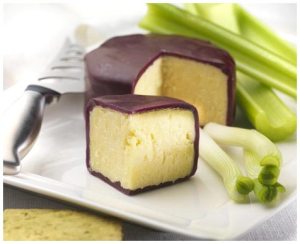‘Check Your Cheddar’ goes the catchphrase of the latest campaign launched by the British Cheese Board, after their research had revealed that the UK, traditional home of Cheddar, actually imported 130,000 tonnes of the stuff last year, and that near half of the supermarkets failed to indicate that this imported cheese was of non-UK origin. Dutifully, bits and pieces of the media picked up this easy filler copy, and ran with it, much as the Mail does here http://bit.ly/9acjQW, blithely asserting the inherent superiority of English cheddar.
All very well and good, noble in fact, at least considered in terms of

Cheddared cheeses in cloth binding maturing at the farm
reducing foodmiles. Probably a lot less than you would imagine, given that most cheese in this country is industrially produced, and that cheese factories buy in their milk rather than having a herd on site. As the massive super-dairies can offer milk at the lowest price, and that the cost of milk rather than locality or quality are the principle concerns of the factory cheese manufacturer, then most industrial cheeses have quite a few food miles under their belt before the cheesemaking and national distribution even begins. But still, checking that the cheese is British would reduce food miles, so fair enough.
What I’m struggling with is the stated aim of the campaign to “ensure that people know what they are buying through increased awareness of cheese origin labelling”. This seems more than a touch mixed up; Knowing where a cheese comes from and Knowing what the cheese is are two distinct entities: knowing that it is made in Sussex, or Latvia or Sydney does not tell me whether it is not, in fact, Cheddar. In fact, I would argue that the Check Your Cheddar drive does more to decrease consumer awareness of what precisely it is when you pick up something labelled ‘cheddar’ than the

Uncheddared, pasteurised bought in milk, wax wrapped, flavour added "cheddar" cheese courtesy of Snowdonia Cheese Company, affronting cheddar 24/7
opposite, in that it legitimises the use of the term ‘cheddar’ for cheeses that are not, by any stretch of imagination, a cheddar. This all sounds a bit radical, and cheese snobbish. But bear with me. We simply need to hit upon a definition of cheddar.
What Cheddar is, or, Welcome to the most deleted and edited paragraph in blogging history
This is an exceptionally tricky subject, and one that is still controversial in cheese circles. What we know is that the progenitor of what we can consider Cheddar was based on a recipe taught to us by the Romans several hundred years ago. However, what we now agree upon as Cheddar hails from the early 1900’s, when the recipe was standardised. I would argue that the most basic requirement of a cheese to dare call itself Cheddar would be that it had been Cheddared during production. Despite the dogged insistence of MS Word’s little wiggly red lines, cheddar is also a verb.
To cheddar a cheese, the curds are first cut into small pieces, releasing more of the liquid whey content than leaving it in larger clumps, and increasing acidity levels. These cut curds are then stacked upon one another, with the bottom curds being placed on the top at regular intervals. This has the effect of evenly applying pressure to the curds, which pushes out further whey, and results in the unique compacted texture and brittleness of the finished cheese. And that’s it. At the least, that’s all that’s required for a cheese to be cheddared, to be a Cheddar. Of course, cutting curds into small pieces, stacking them and then alternating their positions in a stack… that’s a bit too labour intensive for a factory. So factory ‘cheddars’ tend to skip the cheddaring step when they produce cheddars. Still, even before we enter the more hotly contested sufficient conditions for Cheddar-hood, with this one step we have pretty much eliminated the majority proportion of the cheeses made in the world that claim to be ‘Cheddar’.
The next condition people often outline for something to be called a Cheddar is that it comes from Somerset/ the West Country. Admittedly this is a view held by the more zealous than usual, but given that cheddar has been made in many countries since the 1800’s, I can’t help feel that this is a case of closing the barn door roughly two centuries after the original horse bolted. By all means we should celebrate the particular buttery, earthy qualities of a good Somerset cheddar, but in my view cheddar was globalised too long ago to insist that it is geographically specific. I’ve tasted lots of dreck that happens to be made in the West Country, and lots of incredible cheddars that hail from elsewhere.

Huntsman: One of the many English Cheeses defended by the British Cheese Board. If you're wondering, that's an inauthentic Double Gloucester interspersed with layers of industrial stilton
The cheese-nerdiest clause – but also perhaps one of the most important – is the variety of starter used to convert milk sugars into lactose acid prior to the renneting. Traditional pint starters of early Somerset cheddars used the mesophilic bacteria present in raw milk of the region. These bacteria tend to produce a mellow, earthy character in the finished cheese. However, more often than not, Supermarkets have demanded a sweeter, sharper character for their cheeses, best achieved with the Thermophilic bacterial starters used in traditional Swiss cheesemaking – these are responsible for the aniseed finish of a good Gruyere. As producers live and die by the whims of the supermarkets, most things called cheddar made in this country use a Swiss style thermophilic starter. I feel this insidious redefinition of cheddar on a daily basis: the first time customer looking for a puckersome sweetness in a traditional English cheddar that simply isn’t there (don’t worry too much: Samaritan that I am I soon help them discover an unanticipated appreciation of handmade Continental European cheese). Regardless, I’m on the fence with this one. There are some great, otherwise traditionally made cheddars coming out of the UK made with thermophilic starters (i.e Lincolnshire Poacher, Hafod etc) that are more deserving of the appellation ‘Cheddar’ than the majority of the vac-packed rubber cheese littering supermarket aisles.
Finally, there are a whole raft of conditions for a cheese to be ‘cheddar’ set out by the Ark of Taste, the project unveiled by the Slow Food Movement to give assistance to heritage foods in danger of extinction. These include the cheddaring clause (which is in my view an absolute requirement), the mesophilic pint starter clause (to which I say: take it or leave it – it produces different cheddars, not things different to cheddar). It also stipulates the use of unpasteurised milk. I can see their point: pasteurised cheeses are not traditional, and simply don’t develop in the same way raw cheeses do; but I think the difference here is between good cheddar/bad cheddar rather than cheddar/not cheddar. They also stipulate traditional cloth binding, which I again sit on the fence with; cloth binding is traditional, and a mostly reliable indicator of a good cheese, but modern cheddars like Lincolnshire Poacher dispose of it (it’s sprayed with some odd compound that permeably seals it for a while before naturally decomposing). Lastly they insist that a cheddar must be made from the milk of the herd on site. Again this is an indicator of good cheese, but not a necessary condition of it. While it’s certainly true that no single condition they set out aside from cheddaring is sufficient to make a cheddar, they are all helpful things to check to ensure that the cheese was carefully prepared outside of factory conditions.
So there you have it: what precisely makes cheese cheddar is hotly contested, but largely confined to the details; for me, as long as someone took the effort to cheddar the cheese, then it’s a cheddar. By no means necessarily a good cheddar, but a cheddar nonetheless, and something worthy of the name. Sadly, the British Cheese Board is even less interested in the details than it is the fundamentals. The pressed, uncheddared, European style, semi-firm, pasteurised bought in milk, immature, vac packed block cheese is, to them, a cheddar as much George Keen’s, or James Montgomery’s, or any of the other handmade, cheddared cheddar cheeses of the UK.
Check Your Cheddar, II

Huntsman Spider: Still more appetising than Huntsman Cheese
Well, hopefully you’re all armed with the information needed to get a decent Cheddar worthy of the name. The point is, not just to check whether that thing in front of you comes from the UK or not, but whether it actually happens to be Cheddar or not. This is the crucial element missing from the discussion, the one bit of consumer empowerment not touched upon: what is our heritage? How has it changed? For better, worse? This is what galls me so much to read the industry voice piece of the BCB telling us to buy British: British what? What precisely has this stuff being sold got to do with our heritage? How can the Mail smugly assume the superiority of British Cheddar, and effortlessly position itself as a defender of English heritage while actual British Cheddars become shifted out of the marketplace in favour of those peculiar plastic wrapped block cheeses that taste like the illegitimate lovechild of Haribo sweets and Sarson’s vinegar? I’m finding myself unable to continue, so to steal/paraphrase Jamie Montgomery (whose family has made cheddar for 100 years) on his recent address on the subject “I dunno.. I’m getting – I’m gonna have to stop soon… I think I’m getting too angry. But there you go.”















